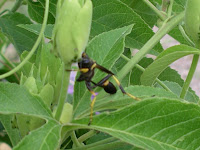I don't know if people call them waterbugs to soften the fact that there are cockroaches in their house or if they just really don't know what a cockroach looks like. But the truth of the matter is waterbug=cockroach; it's the same thing, just a "cuter" name. Actually, now that I sit down and think about it, those little guys need a cuter name given to them. So many people think cockroaches are extremely disgusting, but I personally think they are quite beautiful. Not only the American cockroach (a.k.a. waterbug), but also others that put the American cockroaches to shame- Pale Border Field Roaches and Cuban cockroaches both come to mind. Now please realize that I'm not some demented mind, I worked on cockroaches for many years while going to college, so my fondness for them grew from there.
Many people are now seeing cockroaches venturing into their homes. With t

he weather we've been having this summer, it's really not a big shock. It's hot and dry outside; the cockroaches often move in during times like we're having in search of water. So, don't panic when you see a cockroach scuttle across your kitchen floor or when it attempts to dive bomb you. You can either squish it with a shoe or, if you're like me, capture and take it back outside.
To reduce the incidence of having these cute little guys and gals coming to visit, inspect the outside perimeter of your home for areas where they might be getting in. Check the weather stripping around your doors and windows and replace any areas that do not have a good seal (if you can see daylight around your door from the inside of your house when the door is closed, bugs can get in). Check the outside perimeter for and cracks & crevices or pipe penetrations that need to be sealed with expanding foam or caulk. Stuff weepholes of homes with brick or stone facades with steel wool or copper mesh (use copper for light colors as steel will rust when it gets wet). All trees and shrubs should be trimmed or pruned so they do not touch or overhang the house as they can be used as a bridge to move into the house. Also, don't pile items up near the house such as firewood, stones, etc.; these can offer good hiding places for cockroaches and provide easier access to the house. You can also apply a perimeter pesticide around the outside of your house if you choose. For more information on cockroach management, see this publication:

 hy egg case on twigs, vines or other locations. The frothy egg case eventually hardens which will help protect the eggs throughout the winter. In the spring, small mantids (nymphs) will emerge from the egg case. It's actually rather interesting to watch as the first mantid out gets a meal delivered to them when the next nymph comes out of the egg case.
hy egg case on twigs, vines or other locations. The frothy egg case eventually hardens which will help protect the eggs throughout the winter. In the spring, small mantids (nymphs) will emerge from the egg case. It's actually rather interesting to watch as the first mantid out gets a meal delivered to them when the next nymph comes out of the egg case.









